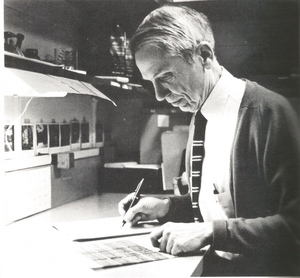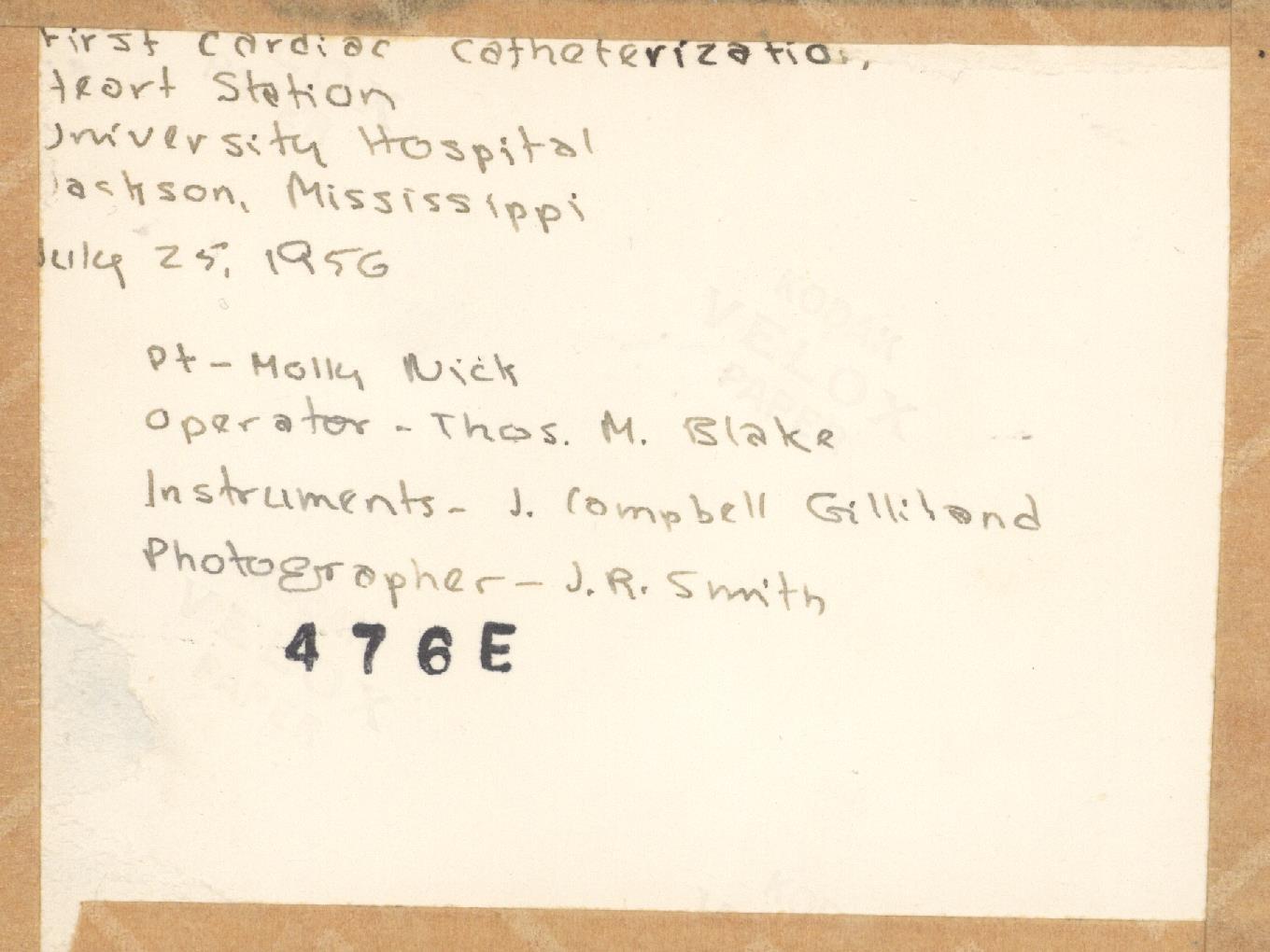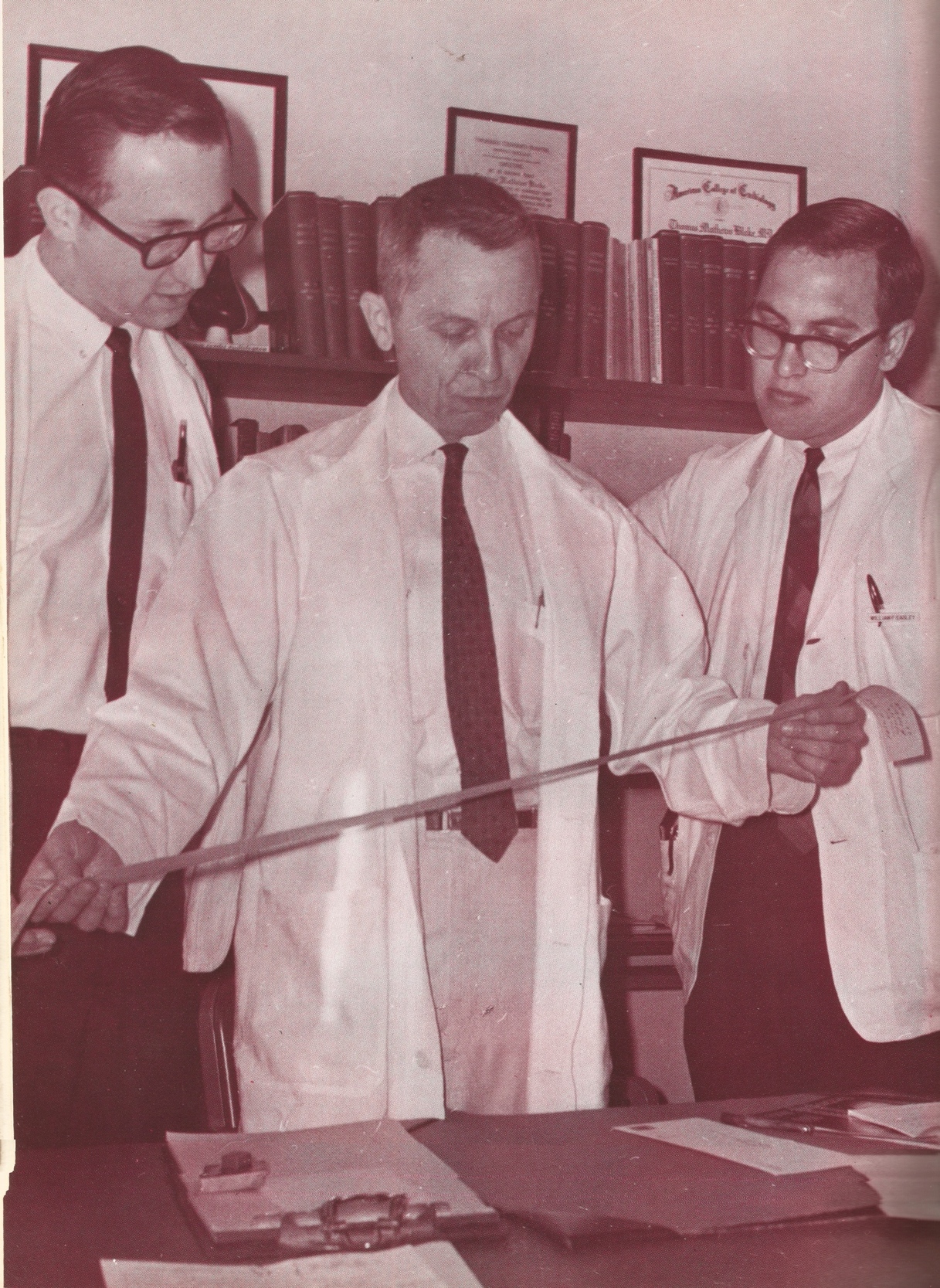THOMAS M. “PETER” BLAKE, MD (1920-2002) AND THE FIRST HEART CATHETERIZATION IN MISSISSIPPI— Dr. Thomas M. “Peter” Blake (1920-2002) was and remains a legendary figure at the University of Mississippi School of Medicine. After training in cardiovascular research at Vanderbilt, he came to work for Dr. John Snavely in the Department of Medicine at the Medical Center when the four-year School of Medicine and the Medical Center opened in 1955. Blake created the hospital’s heart catheterization lab and became the Medical Center’s authority on electrocardiography. This first image, which dates to July 25, 1956, is of the University’s first cardiac catheterization in the Heart Station. Dr. Blake was a photographer but, interestingly, he is the subject of this photograph. The original, which is part of Blake’s extensive collection of photographs at the UMMC Archives, has the writing of Dr. Blake on the back explaining the scene: “First Cardiac Catheterization. Heart Station. University Hospital. Jackson, Mississippi. July 25, 1956. Pt- Molly Nick. Operator-Thomas M. Blake. Instruments- J. Campbell Gilliland. Photographer- J. R. Smith.”1,2
Despite his pioneer work with heart catheterization and electrocardiography, Dr. Blake is perhaps most fondly remembered for his work on the original faculty as a beloved instructor of medical students, interns, and residents. As an Associate Professor in the Department of Medicine, he organized the primary course in physical diagnosis at the new medical school, a course that is still taught, now entitled “Introduction to Clinical Medicine.” This is the final class that second-year medical students complete before initiating their clinical years, a foundational course for future physicians. Blake taught generations of medical students not only how to read an EKG but also how to take a history, do a physical, and take a review of systems. This course, which he crafted, basically taught students how to practice medicine. In his capacity as an attending physician and a member of the medical clinical faculty, he was often asked by medical students and residents, “How should I treat this patient?” He would respond with the simple phrase, “Do the right thing, son.” This maxim is recalled as Dr. Blake’s “command.” Included next are two more images of Dr. Blake. Included next are two more images of Dr. Blake. One pictures him from 1964 teaching two students how to read EKGs. The next other shows him reading an EKG at his desk in 1981.3,4
In 1969, Dr. Blake reflected on the role of a teacher of medicine in the medical school annual. He stated, “There is some question whether teachers really teach at all, but I choose to think they do. Learning is undoubtedly a more important process than teaching, but the teacher participates by providing information, stimulation, support, criticism, and guidance. The opportunity to influence the development of thought processes and sense of values in young people who oftentimes have a greater potential for effectiveness than the teacher himself must be one of the most stimulating, frustrating, and rewarding experiences there is.”5 These remarks reflect the essence of his famous command. His desire to develop thinking as well as a sense of values in his students is plainly evident, as well as his perception of the limits of what a teacher can do. Perhaps, guiding and stimulating students to do the right thing may be the best any clinical teacher can do.
Dr. Blake officially retired in 1990, but continued to teach EKG interpretation half-days (teaching me in 1992). His avocation as a photographer positions him as the Medical Center’s unofficial documentary historian. His numerous black-and-white photographs reveal with perceptive detail multiple decades of the daily life of the institution he so long served before his death in 2002. (For more on Dr. Peter Blake and his famous command, see my “From the Editor” in this Journal.)
If you have an old or even somewhat recent photograph which would be of interest to Mississippi physicians, please send it to me at drluciuslampton@gmail.com or by snail mail to the Journal. — Lucius M. “Luke” Lampton, MD; JMSMA Editor








